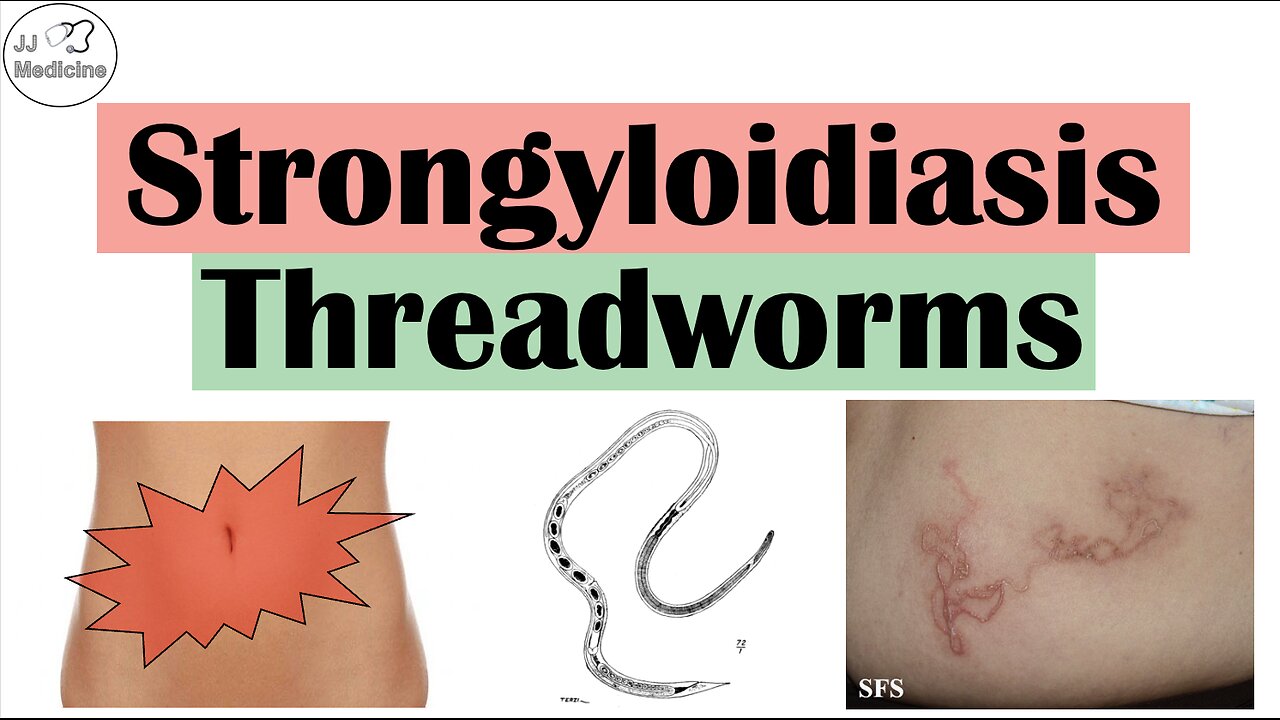Premium Only Content

Strongyloidiasis (Threadworms) | Causes, Pathophysiology, Signs and Symptoms, Diagnosis, Treatment
Strongyloidiasis (Threadworms) | Causes, Pathophysiology, Signs and Symptoms, Diagnosis, Treatment
Strongyloidiasis (also known as Threadworms) is a relatively underreported but prevalent parasitic infection that causes dermatological, gastrointestinal and respiratory symptoms. Individuals can become infected by walking on bare feet and becoming exposed to larvae in the sand or soil. Larvae penetrate into the skin and migrate to the small intestines, where they mature into adult forms and release eggs that mature into larvae that are then excreted into the patient’s stool that is then released into the environment. In this lesson, we discuss the full in-depth overview of the pathophysiology of this condition, including the signs and symptoms, how it’s diagnosed and how it’s treated.
I hope you find this lesson helpful. If you do, please like and subscribe for more lessons like this one!
JJ
REFERENCES:
https://www.ncbi.nlm.nih.gov/books/NBK436024/
**MEDICAL LEGAL DISCLAIMER**: JJ Medicine does not provide medical advice, and the information available on this channel does not offer a diagnosis or advice regarding treatment. Information presented in these lessons is for educational purposes ONLY, and information presented here is not to be used as an alternative to a healthcare professional’s diagnosis and treatment of any person/animal. Only a physician or other licensed healthcare professional are able to determine the requirement for medical assistance to be given to a patient. Please seek the advice of your physician or other licensed healthcare provider if you have any questions regarding a medical condition.
-
 LIVE
LIVE
FreshandFit
7 hours agoArt Basel IRL Stream
6,258 watching -
 2:13:41
2:13:41
TimcastIRL
2 hours agoCNN SLAMMED For Claiming BLACK J6 Bomb Suspect IS A WHITE MAN w/ Milo & George Santos | Timcast IRL
114K107 -
 2:13:17
2:13:17
TheSaltyCracker
2 hours agoPipe Bomb Bull Sh*t ReeEEStream 12-05-25
43.7K101 -
 LIVE
LIVE
Flyover Conservatives
21 hours agoUnmasking Antifa: Inside the Red–Green Revolution Aimed at the U.S. Constitution - Kyle Shideler | FOC Show
316 watching -
 55:26
55:26
Sarah Westall
2 hours agoJobs Losses Hit the Millions, Real Estate Nightmare, Repo Markets, & more w/ Andy Schectman
5.04K4 -
 1:32:12
1:32:12
Glenn Greenwald
7 hours agoGlenn Answers Your Questions on an Un-American Candidate in TX, Escalating War with Venezuela, Trump's Loyalty to Miriam Adelson, and More | SYSTEM UPDATE #554
90.9K29 -
 3:49
3:49
Gamazda
5 hours ago $3.20 earnedABBA - Dancing Queen (Piano)
11.6K10 -
 1:03:20
1:03:20
BonginoReport
5 hours agoCNN’s Colorblindness Strikes Again! - Nightly Scroll w/ Hayley Caronia (Ep.191)
110K37 -
 1:26:55
1:26:55
The Daily Signal
4 hours ago $6.61 earned🚨BOMBSHELL: Minnesota Somali Fraud Scandal Gets WORSE, $8 Billion Lost, Gas & Oil Prices Plummet
21K11 -
 17:44
17:44
tactical_rifleman
10 hours ago $3.72 earnedMilitary's New Belt-Fed Machine Gun | MCR | Tactical Rifleman
15.9K10